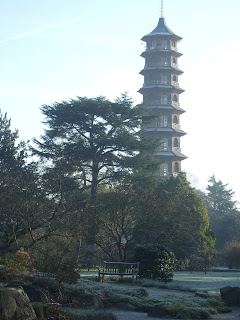The roofs of the Chinese Pagoda at Kew Gardens will be again '...covered with plates of varnished iron of different colours... All the angles of the roofs [will be] adorned with large dragons, being 80 in number, covered with a kind of thin glass of various colours, which produces a most dazzling reflection, and the whole ornaments at the top [will be] double gilt.' Its walls will be '...well coloured and well matched grey stocks, neatly laid, and with such nice care, that there is not the least crack of fracture in the whole structure...'
Between 1757 and 1762, Sir William Chambers taught drawing and architecture to the future King George III three mornings a week. Besides, he worked full time to design new buildings for Kew. He produced around twenty of them, each one an excellent example of a different architectural style. Many were built in wood, covered with plaster and painted in oil colours to save money. Except the Chinese Pagoda, which was 'esteemed one of the finest pieces of brick work in England.'

Pagodas were not absolute novelty in gardens, but the one at Kew became a model and was imitated all over Europe: a 49.6-metre-high tower, composed by ten octagonal storeys of decreasing size, 'the lowest of these is 26 feet in diameter, exclusive of the portico which surrounds it, and 18 feet high, ....the 10th story is 17 feet in diameter and, with the covering 20 feet high.'
From the top storey, in a comfortable room, one could enjoy an impressive vista 'over a rich and variegated Country.' The Pagoda stood above a sea of dark green trees, the “Wilderness”, flanked by two smaller buildings and the ha-ha, or sunken fence, which separated the garden from meadows and pastures. The two buildings were the Moorish Alhambra and the Turkish Mosque. The first, built in 1758, was inspired by a design of Johann Heinrich Muntz with open loggias and slender brilliant red columns. The second was erected three years later developing Fischer von Erlach’s designs and faithfully reproducing minarets and Arabic inscriptions. The three buildings completed southward the circuit path that ran around the Gardens uncovering botanical treasures and a landscape shaped by man with hills, woods, a lake and a variety of structures and temples.

The ongoing restoration of the Chinese Pagoda will return that atmosphere.
 quotations from: A description of the gardens....
quotations from: A description of the gardens....

Photos:
TravelinaGarden, Kew Gardens, UK, December 2012.
Further reading:
A description
of the gardens and buildings at Kew, in Surrey : with the engravings
belonging thereto in perspective. To which is added, A short account of
the principal seats and gardens in and about Richmond and Kew, 1763.













